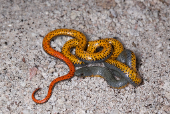Regal Ringneck Snake (Diadophis punctatus regalis)
Description: The regal ringneck snake is typically gray in color, with a dark-speckled white or cream underside, which becomes bright red or orange near and under the tail. It is distinguished by a yellow to orange ring around its neck which is typically bordered with black. However, the neck ring is frequently absent in this subspecies. The belly color extends onto one or more dorsal scale rows. They are among the larger of the ringneck snake subspecies, growing to a total length (including tail) of 7.9 to 34.3 inches. Their dorsal scales are smooth.
Habitat: The regal ringneck snake is found in the desert, and in the mountains, unlike most snakes.
Range: Regal Ring-necked Snake has been found in California in isolated populations in the Clark, Providence, and Grapevine Mountains. Beyond California it can be found in isolated locations in Idaho, Nevada, Utah, and Arizona, then in a continuous range from southeast Arizona into New Mexico and south into Mexico. There is also a large range in Texas that is a range of intergradation with the Prairie Ring-necked Snake.
Diet: The regal ringneck snake, unlike other subspecies, is almost exclusively ophiophagous, having a diet that consists primarily of other snakes, such as the earth snakes (genus Virginia) and the blackhead or flathead snakes (genus Tantilla). They have enlarged rear teeth (opisthoglypha) and a weak venom that serves to immobilize their small prey, but is harmless to humans.
Reproduction: Mating occurs throughout the warmer months, with 3 to 10 eggs being laid at a time in a moist, protected area, sometimes in a communal nest with the eggs of several other females. The eggs are on average 3/4-inch long by 1/4-inch wide.
Status: Listed as Least Concern in view of the very large and probably relatively stable extent of occurrence, area of occupancy, number of subpopulations, and population size. This species is not threatened in most of its range.
»» Kingdom: Animalia - Animals
»» Phylum: Chordata - Chordates
»» Subphylum: Vertebrata - Vertebrates
»» Class: Reptilia - Reptiles
»» Order: Squamata - Scaled Reptiles
»» Suborder: Serpentes
»» Superfamily: Colubroidea
»» Family: Colubridae - Colubrids
»» Genus: Diadophis
»» Species: Diadophis punctatus - Ringneck Snakes
»» Subspecies: Diadophis punctatus regalis - Regal Ringneck Snake
This article uses material from the Wikipedia article "Diadophis punctatus regalis", which is released under the Creative Commons Attribution-Share-Alike License 3.0. Content may have been omitted from the original, but no content has been changed or extended.
|








